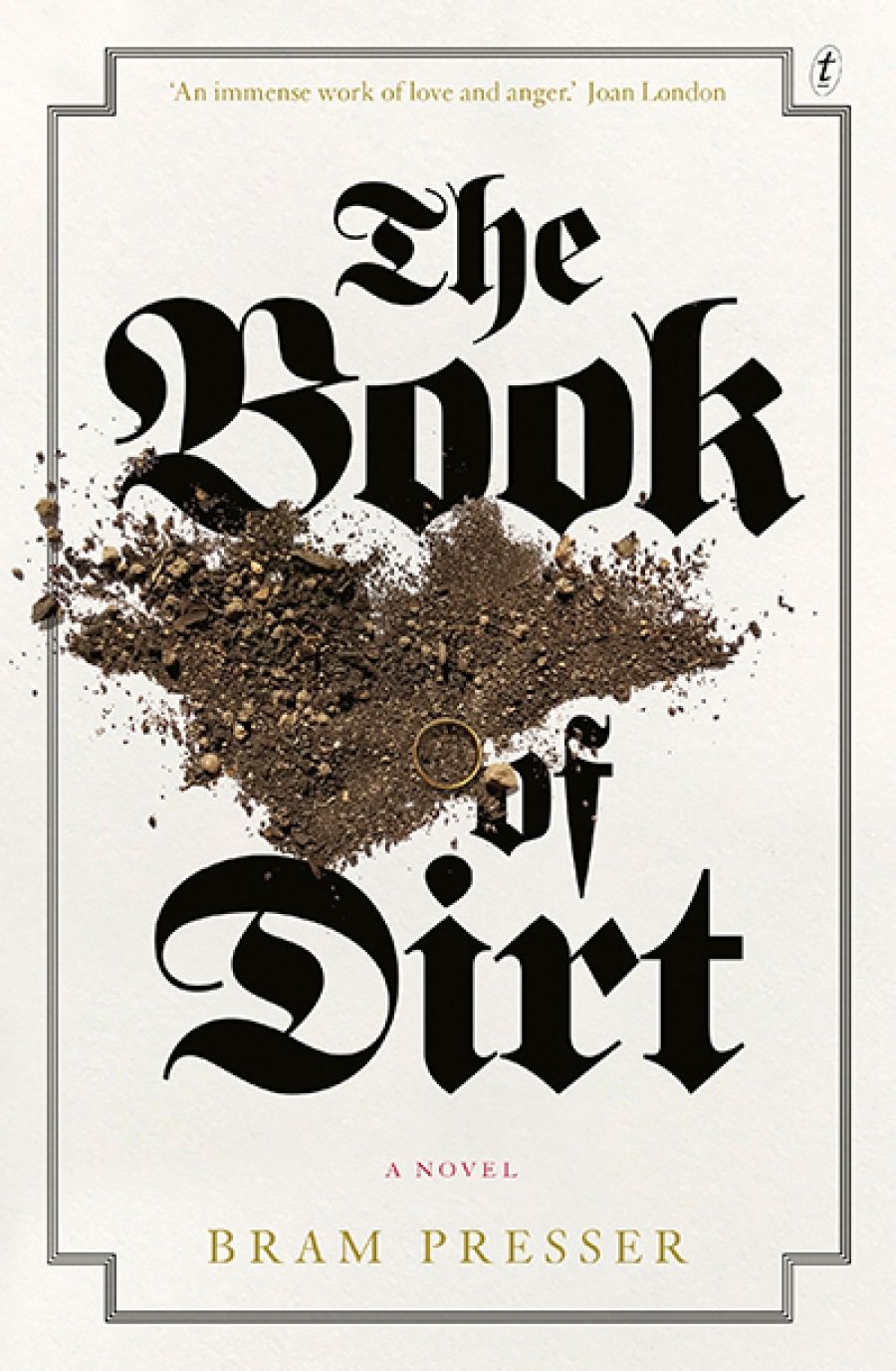
- Free Article: No
- Contents Category: Fiction
- Custom Article Title: Anna MacDonald reviews 'The Book of Dirt' by Bram Presser
- Review Article: Yes
- Online Only: No
- Book 1 Title: The Book of Dirt
- Book 1 Biblio: Text Publishing, $32.99 pb, 303 pp, 9781925240269
For readers of Sebald it is impossible not to recall his prose narratives – Austerlitz (2001), especially – in aspects of Bram Presser’s The Book of Dirt. Presser’s novel relates a grandson’s quest to understand the experiences of his grandparents, Jakub Rand and Daša Roubíčková, who survived deportation from Prague, first to Theresienstadt then to Auschwitz-Birkenau, Sachsenhausen, and (for Daša) a factory in Merzdorf, Silesia. The novel shifts between first-person essayistic sections that describe the narrator’s search for traces of his grandparents – in the archives of Yad Vashem and Beit Theresienstadt (both in Israel), on the streets of Prague, at Terezín, and the site of the Czech Family Camp at Auschwitz – and a more conventionally novelistic narrative in which the lives of Jakub, Daša, their families, friends, and fellow prisoners are re-imagined in light of these researches.
As in Sebald’s prose narratives, Presser’s novel inhabits the dynamic region between fiction and non-fiction. The narrator is also named Bram Presser. The archive, and the problems associated with memory and historical representation are ever-present. The Book of Dirt integrates word-text alongside family photographs, reproductions of letters and archival documents, and pictures taken by the author, a number of which echo photographs that appear in Austerlitz. Like Sebald’s protagonist – whose mother was deported to Theresienstadt, and who returns to the city of his birth in search of his parents and his childhood self – Presser’s narrator wanders the streets of the Old City ‘hoping to find’ traces of his grandparents: ‘Could it be that, walking where they, too, once walked, I might feel them again, in a warm gust of air, a tightening of the hand, a familiar scent drifting from a nearby restaurant?’
The similarities between Austerlitz and The Book of Dirt are, at times, startling. However, interestingly, Presser seems to be borrowing certain narrative techniques from Sebald while using them to argue against the latter’s narrative project.
Sebald made a point of approaching sites and experiences of horror ‘obliquely, tangentially, by reference rather than by direct confrontation’ (interview with Michael Silverblatt, 2001). For Presser, by contrast, looking directly at the horror of the Holocaust is crucial to the responsibility he and his narrator have assumed. Presser makes inventories in Sebaldian fashion, but his lists are not of architectural features or varieties of moths; they are, rather, of names, ages, sites of death, types of death. Presser writes lucidly of the indignities of transportation and camp life: of beatings, rapes, starvation, and the stench of burning human flesh. He re-imagines the sounds that accompany extreme brutality:
Gasps, whimpers, sobs. The steady hum of electricity pulsing across deadly filaments. Dogs: panting, barking, scratching at wood. The swish of buckets filled with human waste. Screams, coughs. An orchestra of motors. The crunch of heavy boots ... No birds. Never any birds.
Presser refrains from evoking the most notorious images. His use of ‘direct confrontation’ is concerned more with persistent silences and an attempt to write out of the fear that ‘[w]ithin a few generations almost all of us will have been forgotten’. In keeping with this aim, Presser credits the photographs he uses, which function more as illustrations to the word-text than do Sebald’s oblique references. And in ‘A Note on Historical Sources’, Presser insists upon the need for ‘transparency and historical fidelity’, itemising the liberties he has taken with particular historical material.
 Bram Presser
Bram Presser
Presser – a descendant of Holocaust survivors – and Sebald – the son of a German soldier – both confront the silences that have obscured the Holocaust. They do so, however, in light of differing inheritances. Sebald refused to ‘abdicate’ his responsibility for ‘the bad dive [German] history took in this century’ (interview with Eleanor Wachtel, 1997). Presser’s narrator describes his complicated inheritance thus:
We, who have been entrusted to perpetuate their memory, to uphold the great refrain of ‘Never again’ ... are left impotent in their silence ... We cannot ask them, our grandparents, our great-uncles and great-aunts, their friends, because, at the time, they chose not to speak and now they are gone. And we cannot find the pieces of the puzzle that make up those few years of their life, for they, too, are gone.
Like its narrator, The Book of Dirt has a complicated inheritance. It looks back to other return journeys (Arnold Zable’s Jewels and Ashes, 1991) and forward to other third-generation attempts to makes sense out of silence (Michel Laub’s Diary of the Fall, 2014). The result of the persistent silences within inherited testimony and the inability of official archives to provide a complete record of events is a perpetual remembering and re-imagining of those ‘few years’ about which many survivors chose to remain silent. Hence the novel structure of The Book of Dirt, the shifts between archival and other researches, and the stories we make from them.


Comments powered by CComment